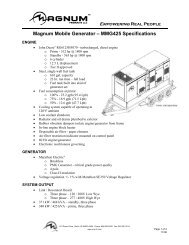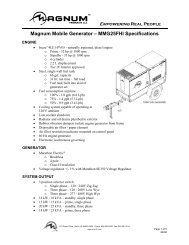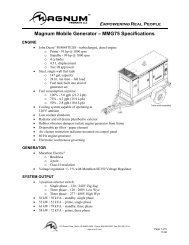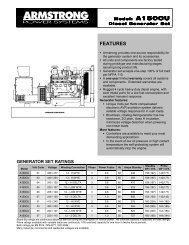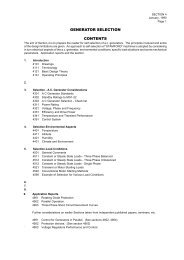GENERATOR SELECTION CONTENTS - Diesel Generator
GENERATOR SELECTION CONTENTS - Diesel Generator
GENERATOR SELECTION CONTENTS - Diesel Generator
Create successful ePaper yourself
Turn your PDF publications into a flip-book with our unique Google optimized e-Paper software.
SECTION 4111<br />
January 1990<br />
Page 5<br />
In this case the load applied causes the current waveform to lag behind the voltage waveform by<br />
a constant amount, i.e., the voltage peaks and zeros occur at constant time before the current<br />
peaks and zeros.<br />
This is the normal situation in a.c. work where a phase or time difference exists between the<br />
voltage and current waveforms. The instantaneous real power in watts is always the voltagecurrent<br />
product for that instant in time. Since voltage and current are no longer in phase, the<br />
summation of all of the instantaneous powers over one cycle will be less than the summation for<br />
the in-phase case.<br />
Hence the power factor figure will reduce from 1.0 to a figure proportional to the amount of<br />
phase or time displacement. Consequently, as the phase difference between the voltage and<br />
current waveforms increases, the power factor figure will reduce, as will the real power output<br />
figure.<br />
Since quite large powers are obtained the unit kW is preferred to the watt (W) where 1000W =<br />
1kW.<br />
Power Factor (p.f) The nature of the load in an a.c. circuit will determine if the current drawn is in phase or out of<br />
phase with the generated voltage. The load again determines if that current waveform ‘leads’<br />
the voltage waveform or ‘lags’ the voltage waveform. For normal industrial loads (e.g. motors)<br />
the current will lag the voltage by some time interval or phase angle. See also kVA and Power.<br />
The optimum situation is where current and voltage are in phase. This makes the power factor<br />
unity (1.0) and hence the real power (kW) the same as the product of voltage and current (kVA).<br />
Conventionally, a.c. generator work considers a lagging power factor of 0.8. In this case the<br />
current will lag the voltage by an amount which causes the real power level supplied (kw) to fall<br />
below the kVA level by a factor of 0.8 times.<br />
It is possible for a load to demand a current which is almost totally out of phase with the generated<br />
voltage. Also that current may be lagging the voltage (inductive or motor loads) or leading the<br />
voltage (capacitive loads). This, therefore, completes the range of power factors for a.c.<br />
generators from zero p.f. lagging through conventional 0.8 p.f lagging to unity (1.0) p.f. to zero<br />
p.f. leading. One aspect of this is that even though only a small real power (kW) is demanded by<br />
the load which is well within the machines capability, damage can easily result if the load is a<br />
very low power factor load demanding a very high kVA level.<br />
The diagram shows difference power factor-kVA loads all supplying the same real power (kW)<br />
level. For normal constant voltage operation the length of the kVA line is directly proportional to<br />
load current. The high current overloads at lower power factors can be easily seen from this<br />
diagram.



